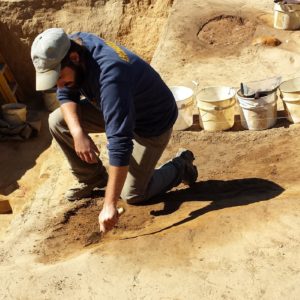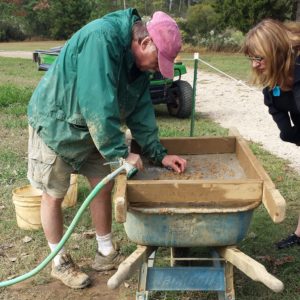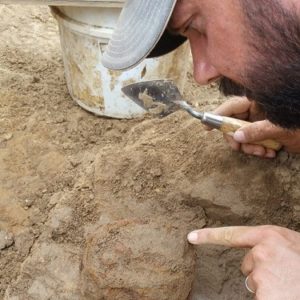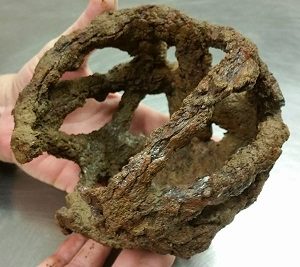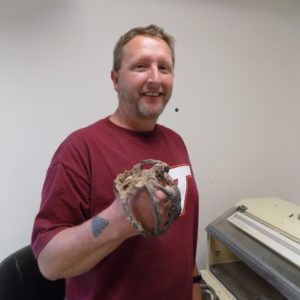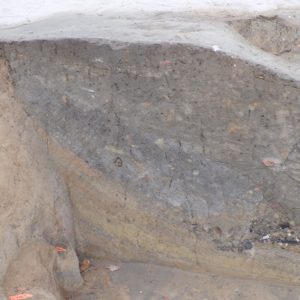The Jamestown Rediscovery archaeologists spent October extending their test north into the remaining fill layers of Structure 193, the cellar at the corner of the 1608 fort extension. As the layers of soil are removed, the team is getting a clearer picture of the cellar’s original size and shape. The top three feet of the cellar’s subsoil walls shows signs of heavy erosion and settling after the cellar was initially back-filled. It is unknown when or for what period the top edge of the feature’s walls were exposed to the elements, but none of the cellar walls have completely held the original shape.
Despite the erosion, there is enough of the cellar’s form to determine that the cellar is L-shaped, and it is divided into an east and west chamber. A square well shaft is located in the cellar’s east chamber and the original floor is 6 feet deep. The west chamber’s floor is approximately 6” higher than the east chamber, showing a clear distinction between the two spaces.
The team also discovered additional small-sized posts carved into and along the cellar walls, and a couple of larger postholes in the floor of the west chamber. The archaeologists are stopping just before the subsoil floor of the cellar in areas where they are encountering soil stains from what appear to be wooden beams or joists. Some may be floor joists related to the colonists’ attempt to stabilize a new floor over the back-filled square well shaft or fallen beams from the structure that stood above the cellar.
Three later 17th-century postholes cut into the fill of the northern portion of the cellar, archaeologists discovered that the west end of the cellar was disturbed by a large pit. The pit’s surface limits are approximately 12 x 6 feet and it is three feet deep. It was dug some time prior to the second quarter of the 17th century because it is sealed by a layer contains artifacts dating to that period. The pit itself contains nothing dated after 1620. In fact, it appears that the colonists dug this hole and then redeposited the fill almost immediately. The archaeologists are puzzled as to its purpose. It is possible that the pit was dug to by the colonists to retrieve something that was buried during the backfilling of the cellar.
A variety of significant artifacts have been found in the cellar this month including an Antwerp coin weight, Irish penny dated 1601, and a glass doublet button. A fragment of an early 17th-century Bartmann jug medallion was found in the early layers of the cellar that matches a medallion fragment found in the fill for the James Fort’s first well. The Bartmann fragment and the discovery of a few tobacco pipes stamped with 1608 pipe maker Robert Cotton’s diamond-shaped maker’s mark suggest that the well in the cellar was used during early fort period. One of the Robert Cotton pipes found recently included the name of a Virginia Company investor stamped on it. Check out our latest Jamestown Rediscovery YouTube video for information about this incredible find.
In our lab, conservator Dan Gamble has been hard at work air abrading the rust from a basket type sword hilt by the team this month. Gamble, says that despite the heavy rust, “The hilt is in great shape! After we finish removing the rust from the hilt, we might be able to detect if there are any secondary metals. Some of the hilts, previously discovered have shown evidence of silver on some of their components.” The rediscoveries continue.
related images
- Archaeologist Bob Chartrand excavates fill in the cellar.
- Chuck Durfor water screens cellar fill.
- A small glass doublet button. A doublet is a close fitting man’s jacket, which is fastened by rows of small round buttons.
- A fragment of a portrait medallion from a Bartmann jug found down in the cellar.
- Conservator Michael Lavin excavates a basket hilt for a sword down in the cellar fill layers.
- The basket hilt in the lab after excavation.
- Conservator Dan Gamble holds the basket hilt that he has been air abrading for the last couple of weeks.
- Fragment of a tobacco pipe made by 1608 pipe maker Robert Cotton.
- Profile of the pit cutting through the cellar fill layers.
- A late 16th-century copper alloy coin weight from Antwerp, Belgium showing St. Michael spearing a dragon underfoot.



